北师大版(2019)高中英语选择性必修第二册 Unit4 Humour Lesson 1 What’s So Funny?公开课课件(共23张PPT)
文档属性
| 名称 | 北师大版(2019)高中英语选择性必修第二册 Unit4 Humour Lesson 1 What’s So Funny?公开课课件(共23张PPT) | 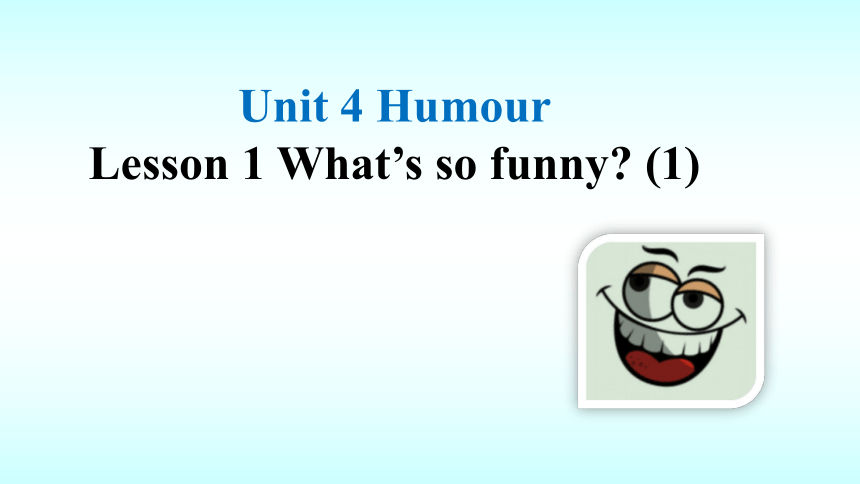 | |
| 格式 | ppt | ||
| 文件大小 | 679.5KB | ||
| 资源类型 | 教案 | ||
| 版本资源 | 北师大版(2019) | ||
| 科目 | 英语 | ||
| 更新时间 | 2023-03-16 15:34:11 | ||
图片预览

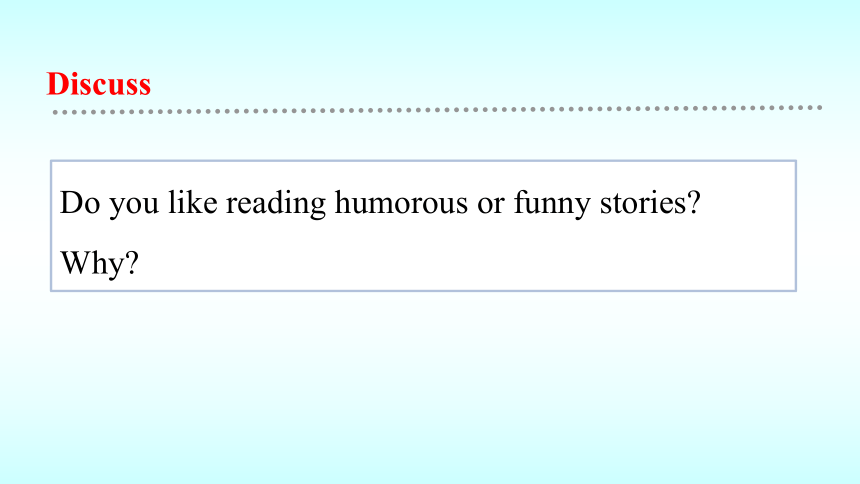
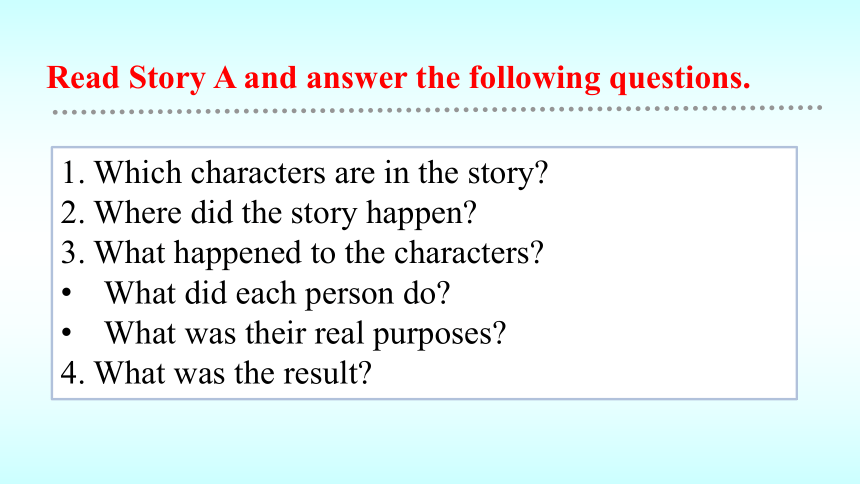
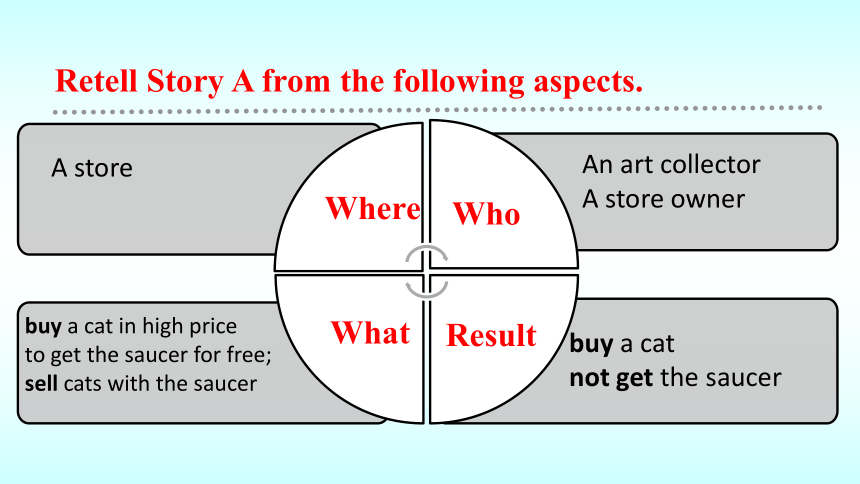

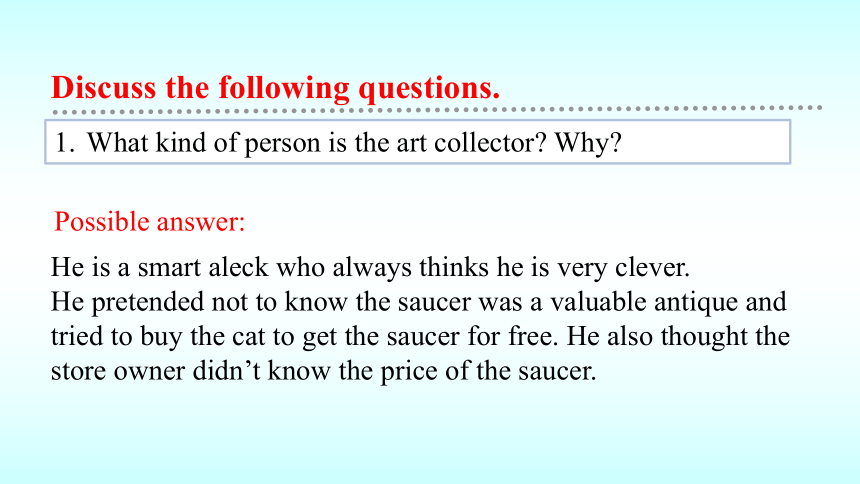

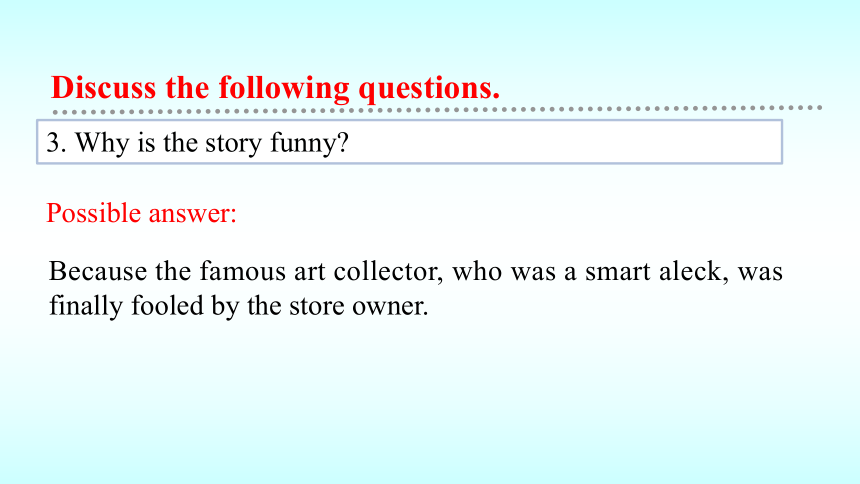
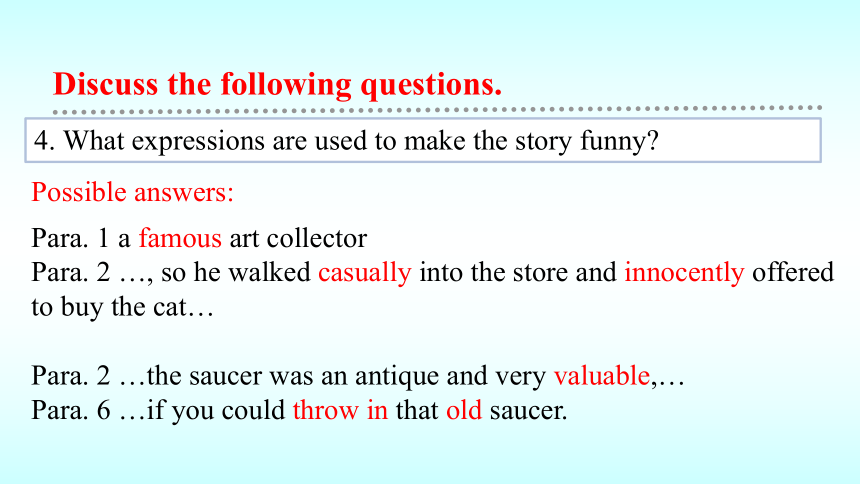
文档简介
(共23张PPT)
Unit 4 Humour
Lesson 1 What’s so funny (1)
Discuss
Do you like reading humorous or funny stories Why
Read Story A and answer the following questions.
Which characters are in the story
Where did the story happen
What happened to the characters
What did each person do
What was their real purposes
What was the result
Retell Story A from the following aspects.
Result
Where
Who
What
A store
An art collector
A store owner
buy a cat in high price
to get the saucer for free;
sell cats with the saucer
buy a cat
not get the saucer
Discuss the following questions.
What kind of person is the art collector Why
What kind of person is the store owner Why
Why is the story funny
4. What expressions are used to make the story funny
He is a smart aleck who always thinks he is very clever.
He pretended not to know the saucer was a valuable antique and tried to buy the cat to get the saucer for free. He also thought the store owner didn’t know the price of the saucer.
What kind of person is the art collector Why
Possible answer:
Discuss the following questions.
He is very cunning and crafty.
He deliberately told the collector the cat was not for sale in order to raise the price. He knew the value of the saucer and refused to give it away to the collector.
2. What kind of person is the store owner Why
Discuss the following questions.
Possible answer:
Because the famous art collector, who was a smart aleck, was finally fooled by the store owner.
3. Why is the story funny
Possible answer:
Discuss the following questions.
Para. 1 a famous art collector
Para. 2 …, so he walked casually into the store and innocently offered to buy the cat…
Para. 2 …the saucer was an antique and very valuable,…
Para. 6 …if you could throw in that old saucer.
4. What expressions are used to make the story funny
Possible answers:
Discuss the following questions.
What do you learn from the story
What is the possible title for the story
Think and Share.
Work in pairs with one reading Story B while the other reading Story C and complete the notes.
Character Where were they What did each person do Real purpose The result
Story B
Sherlock
Holmes
On a camping trip
He asked Watson what he could deduce from the stars in the sky.
He wanted Watson to notice that their tent was stolen.
Watson didn’t realise it.
Work in pairs with one reading Story B while the other reading Story C and complete the notes.
Character Where were they What did each person do Real purpose The result
Story B
Dr. Watson
On a camping trip
He made four different inferences about the stars he saw.
To make reasonable inferences as possible as he could based on his knowledge.
He didn’t realise their tent was stolen.
Character Where were they What did each person do Real purpose The result
Story C
The middle-aged man
In a hospital
He was feeling down and went to see the doctor.
To seek medical help from the doctor.
Everything was OK for him and he just needed a good laugh.
Work in pairs with one reading Story B while the other reading Story C and complete the notes.
Work in pairs with one reading Story B while the other reading Story C and complete the notes.
Character Where were they What did each person do Real purpose The result
Story C
The doctor
In a hospital
She examined the middle-aged man and suggested he see the performance of Grock, an amazing clown.
To help ease his grief.
The man was Grock.
Tell the story you’ve read from the following aspects.
Result
Where
Who
What
…
…
…
…
Discuss the following questions.
What is the funny part of each story
Why is each story funny
What expressions are used to contribute to the funny effects of each story
Story B
Shelock and Dr. Watson saw millions of stars at night because someone had stolen their tent.
Story C
The doctor suggested the middle-aged man see the performance of Grock, an amazing clown but actually he was Grock.
1. What is the funny part of each story
Discuss the following questions.
Possible answer:
Story B
Dr. Watson made so many reasonable inferences based on his knowledge but failed to deduce their tent was stolen.
Story C
An amazing clown who could make others laugh couldn’t make himself laugh.
2. Why is each story funny
Discuss the following questions.
Possible answer:
Story B
Parallel structure like “according to…” is used to highlight the rationality and specialty of Watson’s deduction, which makes it funny when readers know their tent was stolen.
3. What expressions are used to contribute to the funny effects of each story
Discuss the following questions.
Possible answer:
Story C
Lots of continuous tenses like “had been going wrong” are used to emphasise the man’s long-time depression, which makes it funny when readers know the man is the clown.
3. What expressions are used to contribute to the funny effects of each story
Discuss the following questions.
Possible answer:
What do you learn from each story
What is the possible title for each story
Think and Share.
Rewrite one of the stories by giving a different ending to make it funnier.
Homework
Unit 4 Humour
Lesson 1 What’s so funny (1)
Discuss
Do you like reading humorous or funny stories Why
Read Story A and answer the following questions.
Which characters are in the story
Where did the story happen
What happened to the characters
What did each person do
What was their real purposes
What was the result
Retell Story A from the following aspects.
Result
Where
Who
What
A store
An art collector
A store owner
buy a cat in high price
to get the saucer for free;
sell cats with the saucer
buy a cat
not get the saucer
Discuss the following questions.
What kind of person is the art collector Why
What kind of person is the store owner Why
Why is the story funny
4. What expressions are used to make the story funny
He is a smart aleck who always thinks he is very clever.
He pretended not to know the saucer was a valuable antique and tried to buy the cat to get the saucer for free. He also thought the store owner didn’t know the price of the saucer.
What kind of person is the art collector Why
Possible answer:
Discuss the following questions.
He is very cunning and crafty.
He deliberately told the collector the cat was not for sale in order to raise the price. He knew the value of the saucer and refused to give it away to the collector.
2. What kind of person is the store owner Why
Discuss the following questions.
Possible answer:
Because the famous art collector, who was a smart aleck, was finally fooled by the store owner.
3. Why is the story funny
Possible answer:
Discuss the following questions.
Para. 1 a famous art collector
Para. 2 …, so he walked casually into the store and innocently offered to buy the cat…
Para. 2 …the saucer was an antique and very valuable,…
Para. 6 …if you could throw in that old saucer.
4. What expressions are used to make the story funny
Possible answers:
Discuss the following questions.
What do you learn from the story
What is the possible title for the story
Think and Share.
Work in pairs with one reading Story B while the other reading Story C and complete the notes.
Character Where were they What did each person do Real purpose The result
Story B
Sherlock
Holmes
On a camping trip
He asked Watson what he could deduce from the stars in the sky.
He wanted Watson to notice that their tent was stolen.
Watson didn’t realise it.
Work in pairs with one reading Story B while the other reading Story C and complete the notes.
Character Where were they What did each person do Real purpose The result
Story B
Dr. Watson
On a camping trip
He made four different inferences about the stars he saw.
To make reasonable inferences as possible as he could based on his knowledge.
He didn’t realise their tent was stolen.
Character Where were they What did each person do Real purpose The result
Story C
The middle-aged man
In a hospital
He was feeling down and went to see the doctor.
To seek medical help from the doctor.
Everything was OK for him and he just needed a good laugh.
Work in pairs with one reading Story B while the other reading Story C and complete the notes.
Work in pairs with one reading Story B while the other reading Story C and complete the notes.
Character Where were they What did each person do Real purpose The result
Story C
The doctor
In a hospital
She examined the middle-aged man and suggested he see the performance of Grock, an amazing clown.
To help ease his grief.
The man was Grock.
Tell the story you’ve read from the following aspects.
Result
Where
Who
What
…
…
…
…
Discuss the following questions.
What is the funny part of each story
Why is each story funny
What expressions are used to contribute to the funny effects of each story
Story B
Shelock and Dr. Watson saw millions of stars at night because someone had stolen their tent.
Story C
The doctor suggested the middle-aged man see the performance of Grock, an amazing clown but actually he was Grock.
1. What is the funny part of each story
Discuss the following questions.
Possible answer:
Story B
Dr. Watson made so many reasonable inferences based on his knowledge but failed to deduce their tent was stolen.
Story C
An amazing clown who could make others laugh couldn’t make himself laugh.
2. Why is each story funny
Discuss the following questions.
Possible answer:
Story B
Parallel structure like “according to…” is used to highlight the rationality and specialty of Watson’s deduction, which makes it funny when readers know their tent was stolen.
3. What expressions are used to contribute to the funny effects of each story
Discuss the following questions.
Possible answer:
Story C
Lots of continuous tenses like “had been going wrong” are used to emphasise the man’s long-time depression, which makes it funny when readers know the man is the clown.
3. What expressions are used to contribute to the funny effects of each story
Discuss the following questions.
Possible answer:
What do you learn from each story
What is the possible title for each story
Think and Share.
Rewrite one of the stories by giving a different ending to make it funnier.
Homework
同课章节目录
- Unit 4 Humour
- Lesson 1 What’s So Funny?
- Lesson 2 Why Do We Need Humour?
- Lesson 3 My Favourite Comedian
- Unit 5 Education
- Lesson 1 Enlightening a Mind
- Lesson 2 The Objectives of Education
- Lesson 3 Understanding
- Unit 6 The Media
- Lesson 1 From Page to Screen
- Lesson 2 Questions about Media
- Lesson 3 The Advertising Game
